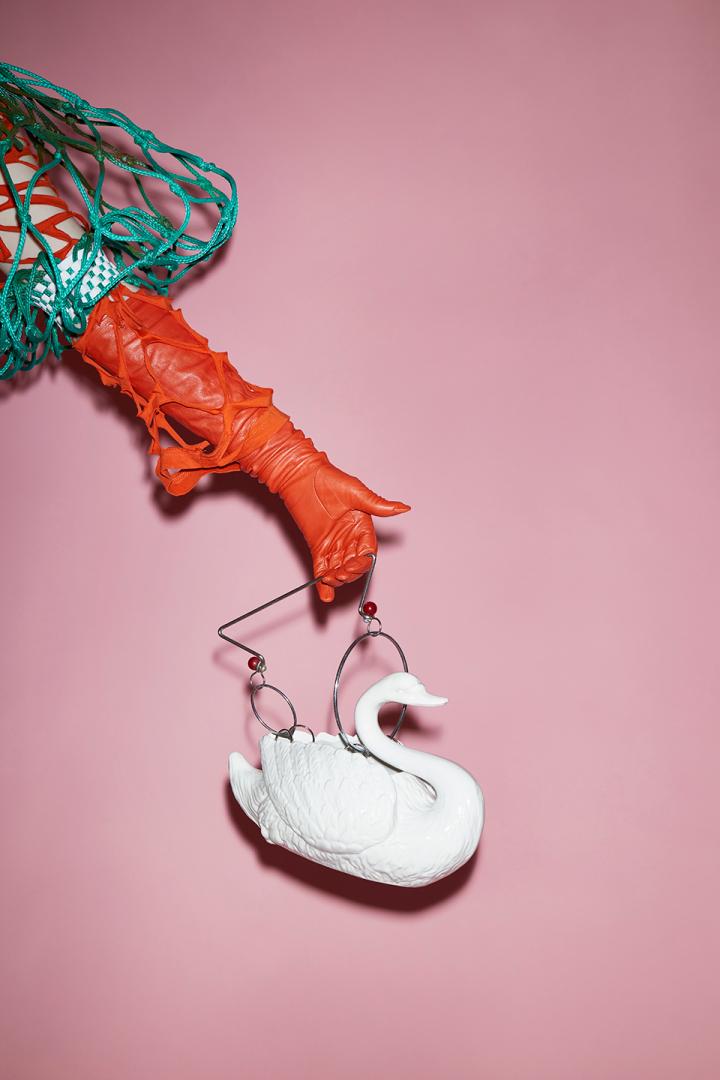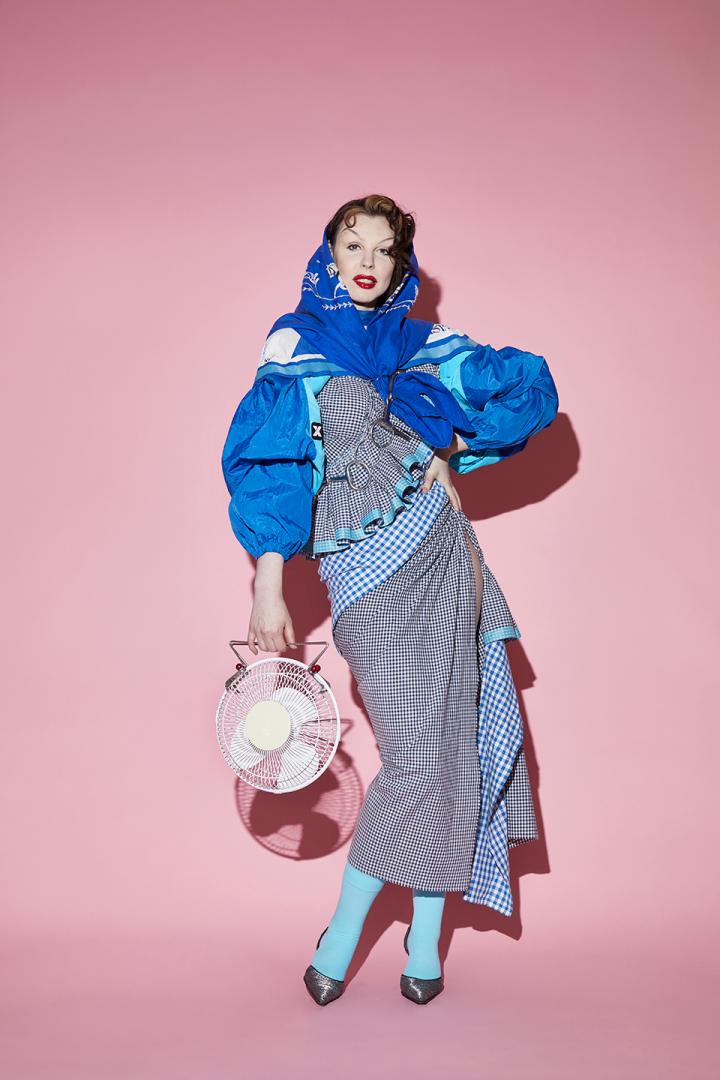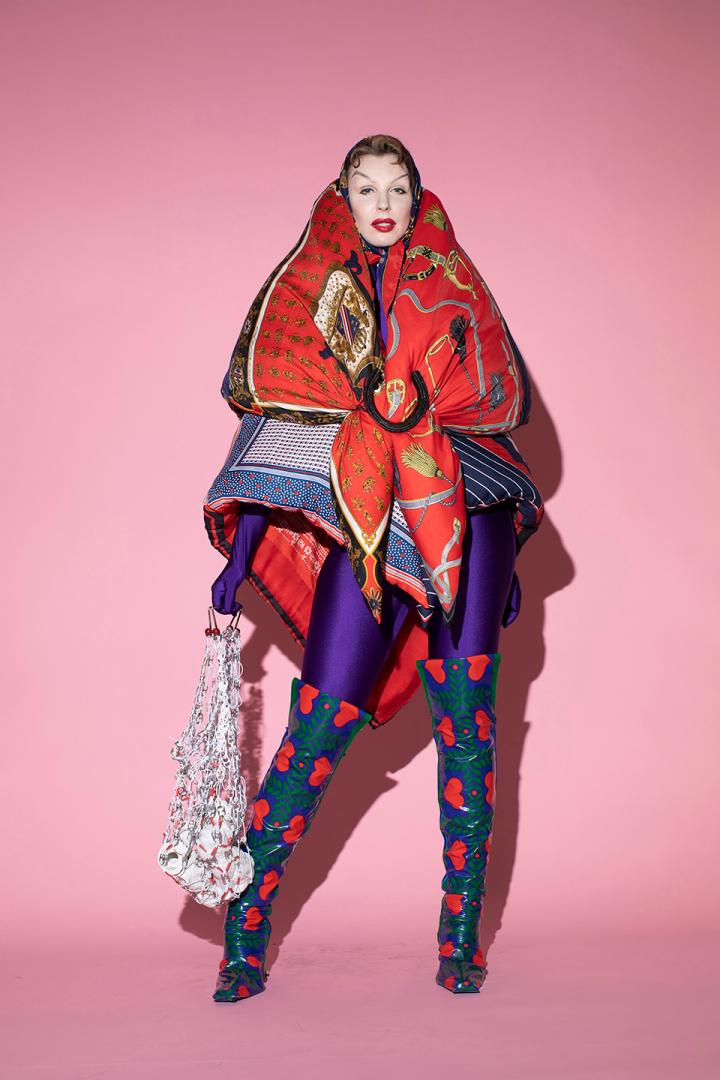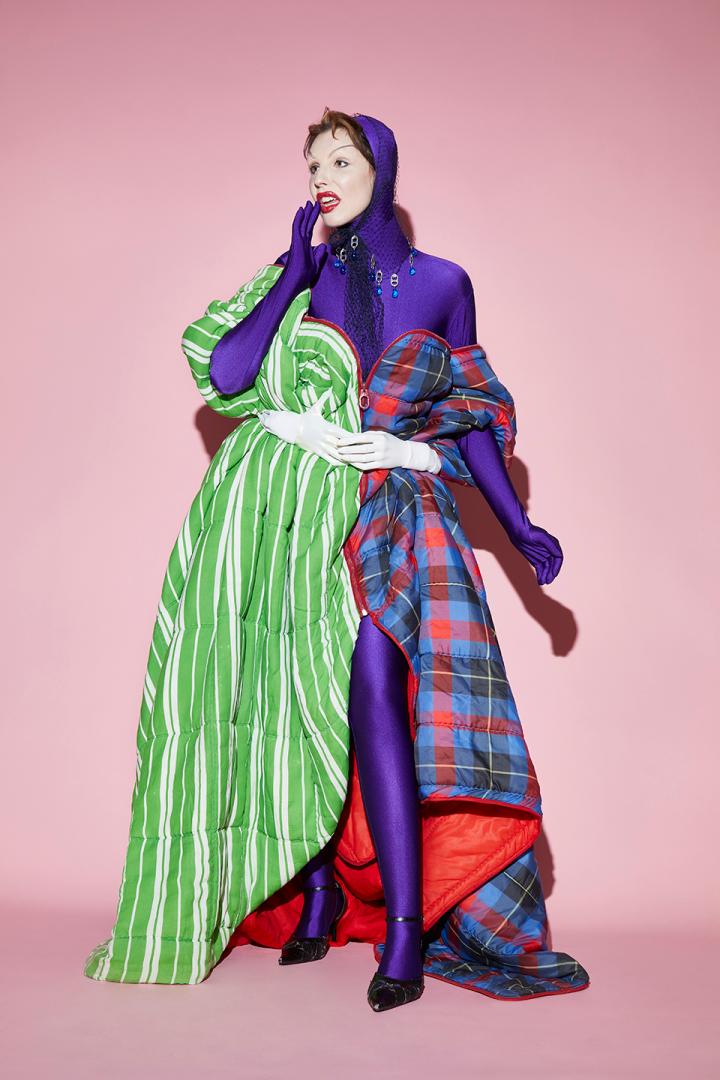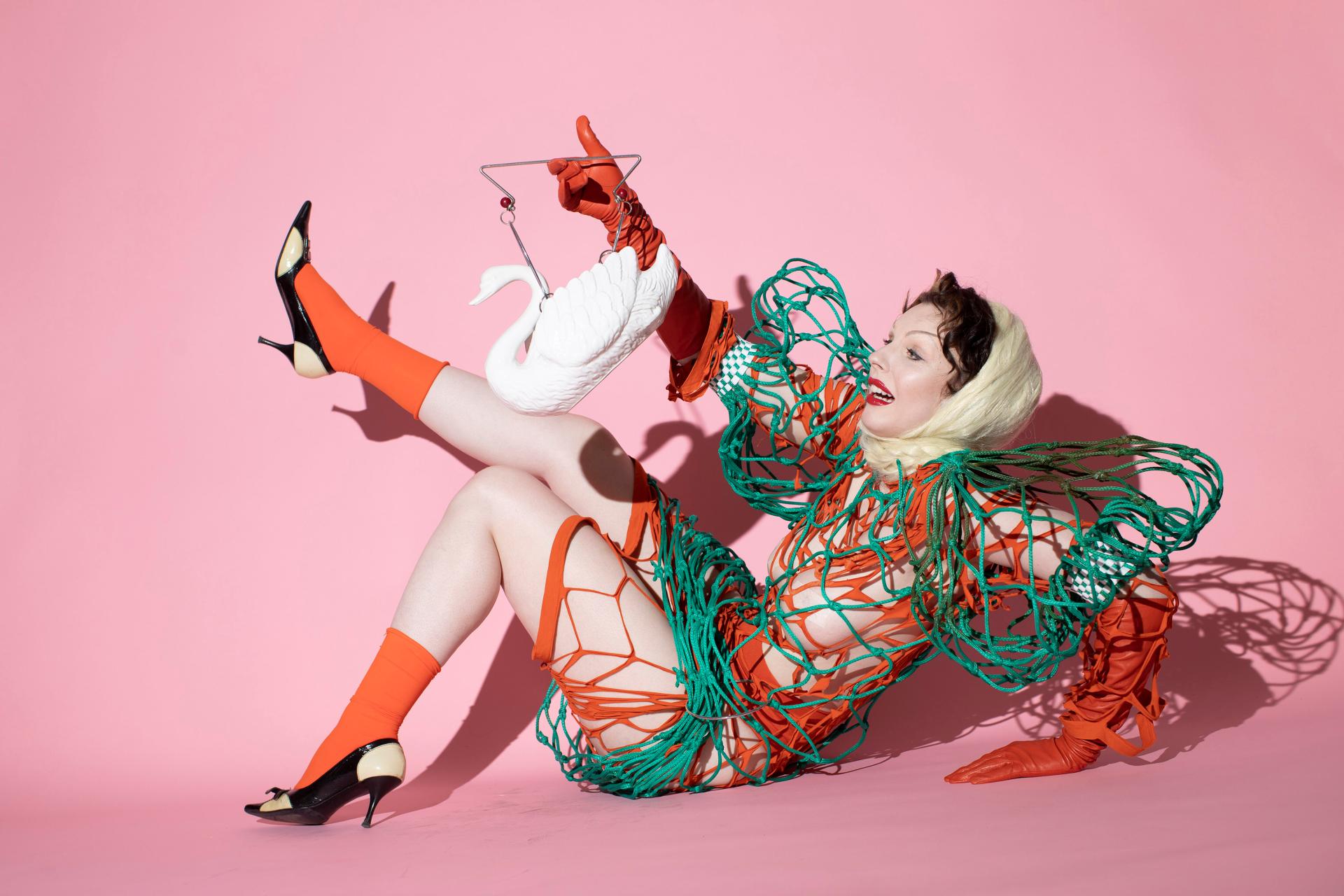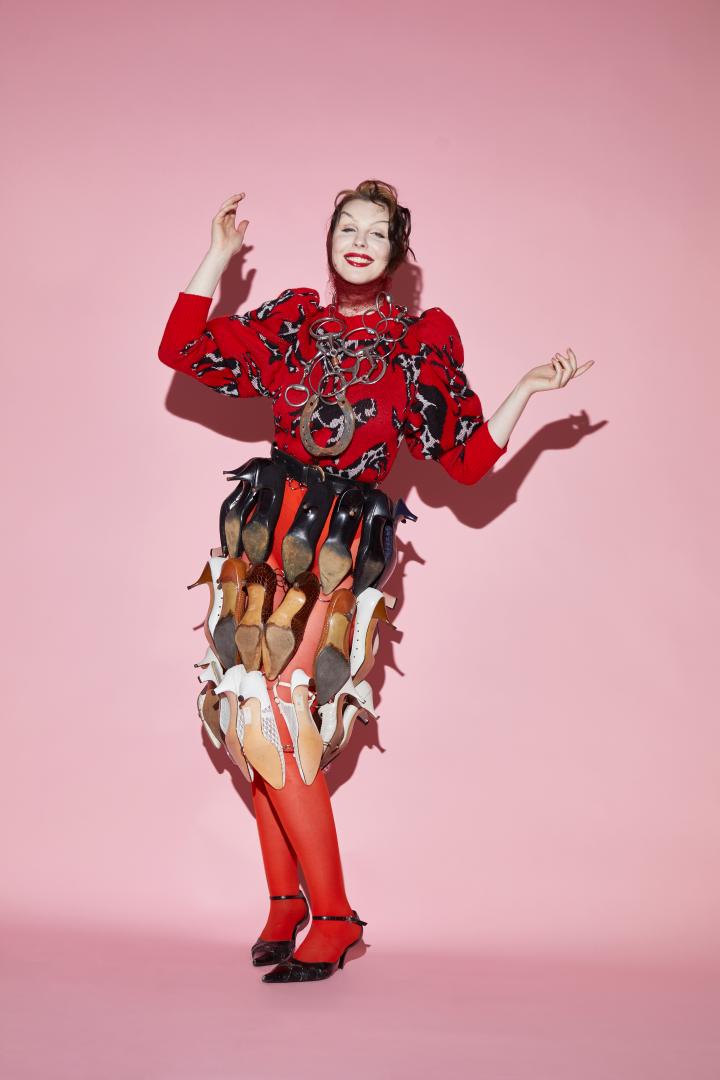Grandmother of Cats - Dressed Drunk
Basic information
Project Title
Full project title
Category
Project Description
The work originates from the muse created to give equal value in discarded material a persona. A crazy-cat-lady-like muse that hoards every possible item in her house, valuing her lowstatus single-use-waste-collection equally to her high-status-material jewelry box. Stating that every material has a value that one can enhance and add to through recontextualization. The collection lifts a serious cause with a touch of humor and therefore make the subject of overconsumption more reachable.
Geographical Scope
Project Region
Urban or rural issues
Physical or other transformations
EU Programme or fund
Which funds
Description of the project
Summary
The five look collection presented is a result on how to better use material surplus generated from overconsumption. These unsellable post-consumer-waste materials is the core to this work. How can one add value to these materials and re-cycle them back into fashion?
To ‘spark new joy’ and attraction and therefore be a tool of sustainable material sourcing, be used again to stop the need for virgin produced materials to subdue our constant need for new fashion to dress our bodies. Furthermost provide a proven and rational design tool for all fields to use within local material harvest from the post-consumer waste streams.
The examples generated by the method are all individual takes upon how awareness of value is imposed. With that said, we need to stop proving value within these waste materials - it is there and have always been.
These design examples portrait the Grandmother of cat’s thought of equal of value in material and dress, fashion hybrids made of post-consumer-waste-materials. Material valued equal from both sides of the scale, the low- and high status have all been represented and re-contextualized in these wearable hybrids.
Materials in generated design examples are all found in (/saved from) Swedish post-consumer waste-streams and are given new contexts, applied manipulations of material, shifts in function and purpose. All this to be perceived as something they before was not.
Going over the top has taken a new meaning. With a large dose of humor and also much seriousness, this work puts its finger on the biggest dilemma of our age: what should we do with our materialistic overload? It looks at the idea of remake in an exiting way that has not only lead to an inspiring collection, but also to a design method with the potential to impact the entire design field. This rich collection of hybrid-clashes piles on the hits with endless value. You laugh out loud, but seriously.
Key objectives for sustainability
To re-design and therefore re-use a material back into life is according to The Ellen MacArthur Foundation (2013) one of the most resource effective solutions for the environment and here of course to use of as much of the material as possible – To leave no leftover from the leftovers.
This work targets these materials, the post-consumer leftovers and aims to give them a new context, purpose, function and therefore value.
Post-consumer-waste materials used within this work is a combination of textile materials and non-textile already made objects, all sourced in different Swedish consumer-waste-streams. A mix of materials to showcase the wide range of possibilities within remake and to embrace the uniqueness of waste-stream goods. This to propose an alternative, more characteristic and powerful expression within remake presented in today’s fashion scene.
In making new from sourced one-of-a-kind materials found in waste streams the end result will keep the uniqness of its heritage and therefore result in a higher valued end product (Sung 2015). The mix between already made solid objects combined with soft textiles will give the work a material depth and variation and therefore also show a wide range of possibilities within re-make into fashion - a recontextualization of objects and the creation of hybrids to wear on your body.
It’s clear that we all have to change our ways of consuming and that we as designers carry the important role to inspire and make post-consumer waste into the obvious choice when sourcing materials.
The motive for this work is therefore to present us with a fun and approaceble alternative to virgin produced goods to satisfy the need for new fashion to dress our bodies.
Key objectives for aesthetics and quality
That designers and brands are turning their eyes upon studio leftovers and sourcing materials in the secondhand market has been a growing trend for long now. This mainly due to the fact that it’s a cheaper alternative to other materials but also for most the sustainability aspect in contrast to virgin produced goods (Rowley 2018). One can also present these discarded materials as a source of inspiration, the wear and tear and natural history of garments will spark the imagination and therfore be a leading part of the designing it self.
To re-contextualize the discarded materials by the creation of wearable hybrids aims to make the mountains of waste more approachable. The method of hybrid-cards developed within this work aim to lift a serious cause with a touch of humor and therefore make the subject of overconsumption more reachable.
Overall, the collection of generated design examples is here collaged together to form a lineup of five looks. They all work well on their own as well together with other garments. Each example a combination of textile materials and/or non-textile objects sourced in different Swedish post-consumer-waste-streams. A mix of materials to showcase the wide range of possibilities within remake and also to embrace the uniqueness of waste-stream goods (Sung 2015).
The examples them self are composed in a fun and colorful way, they are all individually bold and bright and togheter they form a well balanced composition within the line-up. All added elements generate harmony for the eye to travel within this maximalistic and somewhat color-sorted aestetic.
This maximalistic expression might be a expected ganre within remake but it is also by the explotion of material presented that one can be even more aware of the huge amout of waste that the fashion consumer leaves every year. The wide range and mix of material is therefore responible to carry that message forward.
Key objectives for inclusion
Since materials used and targeted within this project is the use of an unused resource it provides a major economical benefit. The material used is currently considered a waste product which makes the price extremely competitive in relation to new production. This in turn is beneficial regarding affordability to both consumer, designer, the sorting facilities and furthermost the environment.
The structure for this work is a playful game of design to generate the examples. To start off with a number of discarded items can be terrifying and the need to decode is key for them to transform into workable material (Lidström 2020). This is where the method of game and playfulness comes in as a tool of ’healthy distancing’ and thereby offers a greater accessibility towards the use of post-consumer waste-materials.
This method is also exemplary for co-design solutions. Companies can add surplus from different fields and targeted needs to work together to generate new hybrids. This can also be implemented towards the consumer. Consumers are given the opportunity to recycle their own personal belongings within the method. Within this work the designers own memorabilia were placed as materials to be used along side other post-consumer surplus. This to further prove the potential of re-make and circular design.
Regarding public-participation it is fundamental to, in the same way as for the equal value in material, invite for equal value in the person wearing or in other ways experiencing the collection. Gender and sizes are all welcome due to smart construction within the pieces it self. When redesigning the designprocess itself its just as easy to include these values in the equation as well.
Results in relation to category
The result of this work is not only be the primary result of presented design examples but also a secondary result, the success of the method itself. As a tool for ’material-harvest’ in one’s own studio or surrounding secondhand sorting facilities, this to propose a substitute for virgin produced goods in fashion design.
The Hybrid-cards: A game or upcycling-design-tool developed by the author that works as a hybrid generator were two or more cards are paired by chance and therefore creates a possible match, see attached thesis-pdf for visual examples. Pictures represent different materials and objects found in post-consumer waste streams alongside representations of possible manipulations, techniques or placements.
The basis of this game is the card game of memory (Ultra 2020) but instead of collecting two identical pictures will this game present you with two (or more) different pictures of either:
- Waste material (garments, textiles, non-textile objets etc...)
- Manipulation technique
These cards then form a ’design-ekvation’, where thing+thing=hybrid. Designer can then proceed with a selection of analyzed characteristics from the drawn combination.
How to play the hybrid-cards:
- Generate possible combinations by the hybrid-cards.
- Analyze generated combinations by visualizing through sketch or imagination.
- Evaluate hybrid, function, the need, material, technique, attraction, humor, muse.
- Realize chosen hybrid.
A great aspect of this variation in result is time, time spent translating the drawn combination into a hybrid, either a quick hands-on way or a slower more analytic one where every characteristics and aspect of original items are considered.
Another result of great impact is of corse the core of this project, to find a use for the piles of surplus already produced. This without a loud of additional energi resources, transportation and to promote local skill and local growth.
How Citizens benefit
It all started during my years working as a textile sorter at one of Swedens Largest secondhand sorting-facilities. There I had the chance to firsthand view and be overwhelmed by all the surplus generated from civil society's overconsumption.
Since a designer works with foremost problem solving this lead me to my design rational: Sustainable materiality. My work have since then targeted a solution for all these materials. To please the need for new things to dress our bodies but to not produce anything new. With this said, this design is created for the citizens and civil society and provide us all with a possible way to clean up our consumption-mess.
Except this involvment during the birth of this ongoing project all materials used within finalizing this collection were donated by the civil society alongside secondhand sorting-facilities and research-facilitie Wargön Innovation. They all have played a great part in testing and accepting the method, providing material and most important reflections and thoughts throwout the process.
Ung Svensk Form voted this collection to be one of 2022´s winners and have thereby received a great audience and appreciation from the public as well as the fashion and design community. Thanx to this work i've been invited to talk during Swedish Fashion Week regarding sustainable fashion and the future of Swedish fashion industry.
The acceptance and success of this projects new take on re-make has lead me to start a local remake studio with biggest focus on public education and to enlighten the consumer within new ways to take part and action in the conversion towards circular fashion and design.
Physical or other transformations
Innovative character
By re-contextualizing these known items into other garments, the new context has a humoristic twist and will therefore be even more approachable. One can say that by changing the items original purpose another type of value is proposed by the shift of function, use and look.
A method that is so visual and present as the hybrid-cards will guide the development and exploration in a very ’hands-on-way’. The hybrids vary from literal translations to more developed and evaluated design examples.
This work compared to mainstream practices of remake in fashion differ in a numerous ways, if starting with the material itself, the most used way of remake is the patchwork. Usually preformed in perfect squares in denim put together in a simple silhouette of a robe or shirt. By cutting squares of the original material used, a lot of surplus is still produced.
In this work the whole item is used and often visible to clearly see or understand its original form and heritage. The collection is made from materials that already exist: “memories” of classics, recut, turned inside out, dissected and collaged, garment are presented to a new context by still reminiscent of their original heritage, origin and objects, and here of course to use of as much of the material as possible – To leave no leftover from the leftovers.
Within the field of remake in fashion it is also usually the 'middle segment' of the waste materials used and produced from. These materials do still have some energy left while this work target the 'lower segment' to be upcycled side by side with any form shape or original object. The materials used within this work is anything from really low valued single use items joined with luxury items sorted as waste due to stains, tears or other faults. All waste materials equal value are now enhanced when recontextualized.
Learning transferred to other parties
This is already in progress. Collaborations with big secondhand sorting-facilities and chains, educational institutions and shoppingmalls are happening. The industry screams for change to be able to turn this spiral upwards. Costumers want to educate them selfs into taking better and greener choices but also to be offered better options. The method itself is applicable in smaller and bigger scale, national and international, for designer, student, big factories or the consumer.
The collaborations with the local secondhand sorting-facilities is as of right now only a provider for material but products generated by the design method are on its way to soon reach chosen stores. Connections through the Dutch institution and designer network New Order of Fashion are on its way with big chains in the Nederlands. This too design prototypes generated by the method to be produced at local micro-factories with an end goal to be sold at local second hand chain.
Swedens largest secondhand sorting-facility are providing material for a special merchandise to be sold at arena gigs preformed by a big Swedish band, on their planned world tour. This since one of the most overproduced fashion item is the t-shirt and therefore something that one with few resources needed can remake and produce in a large scale.
Workshops in the method are hold at local fashion educations, with great results and appreciation.
All above (and plenty more) are ongoing chain reactions generated from this work and are currently happening trough a remake studio based here in Gothenburg, Sweden. The studio is called HURRA PANGPANG (Swedish for HURRAY BANGBANG) and are basing all its work and contribution to the field of sustainable fashion due to, and based upon, this work.

